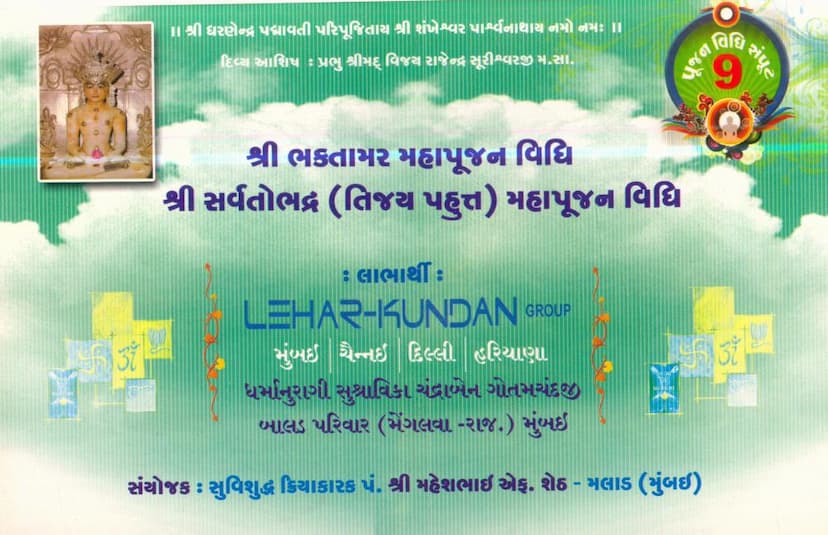Poojan Vidhi Samput 09 Bhaktamar Mahapoojan Vidhi Sarvatobhadra Tijaypahutta Mahapoojan Vidhi
Added to library: September 2, 2025

Summary
This document is the Gujarati text for the "Poojan Vidhi Samput 09 Bhaktamar Mahapoojan Vidhi Sarvatobhadra Tijaypahutta Mahapoojan Vidhi" (Book Title: Ritual Collection Volume 09: Grand Bhaktamar Puja Ritual, Grand Sarvatobhadra (Vijay Patutta) Puja Ritual).
Here's a breakdown of the content:
Overall Purpose:
The book provides detailed rituals for performing a "Mahapoojan" (grand worship) ceremony. Specifically, it focuses on two major rituals:
- Bhaktamar Mahapoojan Vidhi: This refers to a grand puja based on the Bhaktamar Stotra, a highly revered Jain hymn praising Lord Parshvanatha.
- Sarvatobhadra (Vijay Patutta) Mahapoojan Vidhi: This is a grand puja associated with the "Sarvatobhadra Mandal" and also mentions "Vijay Patutta," likely referring to a specific tradition or school within Jainism. The term "Sarvatobhadra" generally implies auspiciousness and protection from all directions.
Key Information and Sections:
- Title and Author: The book is titled "Poojan Vidhi Samput 09 Bhaktamar Mahapoojan Vidhi Sarvatobhadra Tijaypahutta Mahapoojan Vidhi," authored by Maheshbhai F. Sheth and published by Siddhachakra Prakashan.
- Dedication and Blessings:
- It begins with a dedication to "Shri Shankheshwar Parshvanathaya," who is described as being "worshipped by Dharanendra and Padmavati." This highlights the importance of Lord Parshvanatha, particularly the idol at Shankheshwar.
- It mentions "Divine Blessings" from "Param Pujya Prabhushri Mad Vijay Rajendra Surishwarji M.Sa." (a respected Jain monk).
- Sponsors and Supporters: The publication is supported by the "Lehar-Kundan Group" from Mumbai, Chennai, Delhi, and Haryana, and dedicated by Chandraben Gautamchandji Balad family. It also acknowledges "Mohan Khedawala" and "Shri Lehar Kundan Group" for their financial support in re-publishing the work. The "Sanyojak" (coordinator) is identified as Pandit Shri Maheshbhai F. Sheth.
- Context of Re-publication: The "Prastavik" (Preface) explains that the original "Poojan Vidhi Samput" (a set of twelve booklets containing 36 rituals) was published three years prior and quickly sold out. Due to demand from religious figures and ritual experts, a re-publication was necessary. The sponsorship by the Lehar-Kundan Group made this possible.
- Specific Ritual Steps:
- Purification: The initial pages (5-7) detail the purification rituals for the space and participants before the puja. This includes:
- Invoking the wind deity (Vayu Kumar) for atmospheric purification.
- Sprinkling fragrant water, invoking the cloud deity (Megh Kumar).
- Purifying the ground, invoking the earth deity (Bhumi Devta).
- Performing "Mantra Snan" (ritual bathing with mantras).
- Internal purification: "Hriday Shuddhi" (heart purification) and "Kalmash Dahan" (burning of sins).
- "Panchanga Vyas" and "Atmaraksha" (self-protection) rituals using specific mantras and mudras. The "Vajrapar Stotram" is mentioned for protection.
- Initiation of Puja for Lord Adinath: The text then moves to the actual puja of Lord Adinath (the first Tirthankara) in the "Sarvatobhadra" section. This involves:
- Contemplating Lord Adinath in the heart.
- Performing "Kshetrapal Pujan" (worship of the guardian deity of the land) with specific mantras.
- Distributing "Raksha Potli" (protection pouches) and tying "Rakhi" (protective threads) on the wrists of participants.
- Invoking and establishing the deity's presence on the altar ("Avahan," "Sthapan," "Sannidhan," etc.).
- Worshipping specific attendant deities like Gomukh Yaksha and Chakreshwari Devi.
- Purification: The initial pages (5-7) detail the purification rituals for the space and participants before the puja. This includes:
- Bhaktamar Stotra Recitation: Pages 10-49 are dedicated to the recitation and interpretation of each of the 44 verses of the Bhaktamar Stotra. Each verse is presented with:
- The Sanskrit verse itself.
- Its Gujarati translation/meaning.
- The "Prabhav" (efficacy/benefit) of reciting that specific verse, often relating to warding off specific ailments, fears, or negative influences, or bringing prosperity and good fortune.
- Associated mantras and "Riddhi" (mantras for invoking specific powers or deities).
- Invocation of Specific Deities/Powers: Throughout the Bhaktamar Stotra recitation, there are mentions of invoking specific deities and their powers using "Riddhi Mantras."
- Conclusion of Puja: The final pages (50-54) describe the concluding rituals, including:
- Performing abhishek (ritual bathing) with pure water.
- "Angaluchhna" (cleaning/wiping).
- "Aarti" (waving of lamps).
- "Mangal Deepo" (auspicious lamps).
- "Shanti Kalash" (peace pot).
- "Chaityavandan" (veneration of the temple).
- The process of bidding farewell to the deities ("Visarjan").
- A prayer for forgiveness ("Kshama Yachana").
- Concluding auspicious verses.
- List of Puja Materials: A detailed list of required materials for the puja is provided, including spices, flowers, fruits, sweets, camphor, incense, fabrics, etc.
- Specific Rituals for 170 Tirthankaras: The latter part of the book (pages 56-59) describes the "Sarvatobhadra (Vijay Patutta) Mahapoojan" which involves the specific worship of 170 Tirthankara Peramtmā (Siddhas) from different regions of the Jain universe (Jambudvipa, Dhataki Khanda, Pushkarardha Dvipa, and various locations within Aiyravat Kshetra and Mahavideh Kshetra). It includes specific names of these Tirthankaras.
In essence, the book is a comprehensive guide for performing elaborate Jain worship rituals, combining devotional hymns, intricate purification rites, and specific invocations to deities and Tirthankaras for spiritual merit, protection, and well-being.